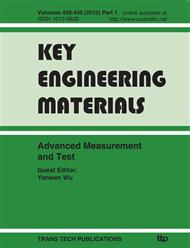[1]
A.Ö. Topaloğlu, M. Topaloğlu: Distance education applications in concept acquisition for disabled individuals/ special education for handicapped, Procedia Social and Behavioral Sciences Vol. 1 1008-1011 (2009), p.1008.
DOI: 10.1016/j.sbspro.2009.01.180
Google Scholar
[2]
M.L. Yuan, S.K. Ong, A.Y.C. Nee: A generalized registration method for augmented reality systems, Computers & Graphics Vol. 29 980-997(2005), p.980.
DOI: 10.1016/j.cag.2005.09.014
Google Scholar
[3]
H. Siegl, M. Hanheide, S. Wrede, A. Pinz: An augmented reality human-computer interface for object localization in a cognitive vision system, Image and Vision Computing Vol. 25 1895-1903 (2007), p.1895.
DOI: 10.1016/j.imavis.2006.04.027
Google Scholar
[4]
Y. Wang, D. Samaras: Estimation of multiple directional light sources for synthesis of augmented reality images, Graphical Models Vol. 65 185-205 (2003), p.187.
DOI: 10.1016/s1524-0703(03)00043-2
Google Scholar
[5]
K.M. Chen L.L. Chen S.T. Shen: Development and comparison of a full-scale car display and communication system by applying Augmented Reality, Displays Vol. 29 33-40 (2008), p.34.
DOI: 10.1016/j.displa.2007.07.002
Google Scholar
[6]
W. Dangelmaier, M. Fischer, J. Gausemeier,M. Grafe, C. Matysczok, B. Mueck: Virtual and augmented reality support for discrete manufacturing system simulation, Computers in Industry Vol. 56 371-383(2005), p.371.
DOI: 10.1016/j.compind.2005.01.007
Google Scholar
[7]
J. Fischer, M. Eichler, D. Bartz, W. StraXer: A hybrid tracking method for surgical augmented reality, Computers & Graphics Vol. 31 39-52(2007), p.31.
DOI: 10.1016/j.cag.2006.09.007
Google Scholar
[8]
R.A. Mischkowski, M.J. Zinser1, A.C. Kübler, B. Krug,U. Seifert, J.E. Zöller: Application of an augmented reality tool for maxillary positioning in orthognathic surgery - A feasibility study, Journal of Cranio-Maxillofacial Surgery Vol. 34 478-483 (2006).
DOI: 10.1016/j.jcms.2006.07.862
Google Scholar
[9]
E. Klopfer, K. Squire: Environmental detectives-the development of an augmented reality platform for enviromental simulations, Education Technology, Research Development Vol. 56 203-228(2008), p.205.
DOI: 10.1007/s11423-007-9037-6
Google Scholar
[10]
D.J. Johnston, M. Fleury, A.C. Downton, A.F. Clark: Real-time positioning for augmented reality on a custom parallel machine, Image and Vision Computing Vol. 23 271-286 (2005), p.271.
DOI: 10.1016/j.imavis.2003.08.002
Google Scholar
[11]
H. Siegl , M. Hanheide, S. Wrede, A. Pinz: An augmented reality human-computer interface for object localization in a cognitive vision system, Image and Vision Computing Vol. 25 1895-1903 (2007), p.1895.
DOI: 10.1016/j.imavis.2006.04.027
Google Scholar
[12]
S.K. Ong, Y. Pang, A.Y.C. Nee: Augmented Reality Aided Assembly Design and Planning, Annals of the CIRP Vol. 56 49-52(2007), p.49.
DOI: 10.1016/j.cirp.2007.05.014
Google Scholar
[13]
Z. Zhou, A.D. Cheok, X. Yang, Y. Qiu, An experimental study on the role of software synthesized 3D sound in augmented reality environments, Interacting with Computers Vol. 16 (2004) , p.1044.
DOI: 10.1016/j.intcom.2004.06.014
Google Scholar
[14]
J. Mott, S. Bucolo, L. Cuttle, J. Mill, M. Hilder,K. Miller, R.M. Kimble: The efficacy of an augmented virtual reality system to alleviate pain in children undergoing burns dressing changes: A randomised controlled trial, burns Vol. 34 803-808(2008).
DOI: 10.1016/j.burns.2007.10.010
Google Scholar
[15]
J. Weidenhausen, C. Knoepfle, D. Stricker: Lessons learned on the way to industrial augmented reality applications, a retrospective on ARVIKA, Computers & Graphics Vol. 27 887-891 (2003), p.887.
DOI: 10.1016/j.cag.2003.09.001
Google Scholar
[16]
D.H. Shin, P.S. Dunston: Evaluation of Augmented Reality in steel column inspection, Automation in Construction Vol. 18 118-129 (2009) , p.118.
DOI: 10.1016/j.autcon.2008.05.007
Google Scholar


